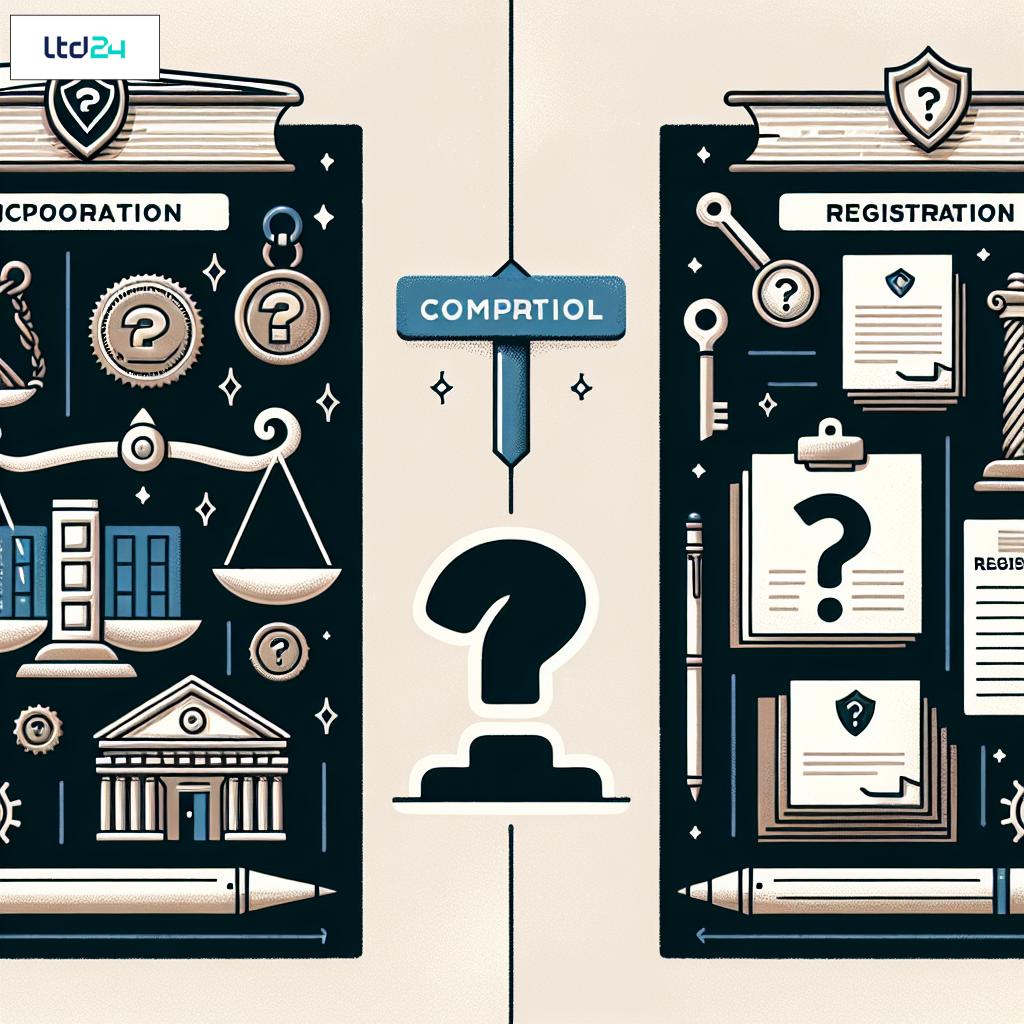Defining Corporate Entities in Modern Legal Systems
A corporate entity represents a legal construct recognized by law as having an existence separate and distinct from its owners or shareholders. This fundamental concept, known as the doctrine of separate legal personality, was established in the landmark case of Salomon v. Salomon & Co Ltd [1896] and has since become a cornerstone of corporate law worldwide. Corporate entities possess the capacity to enter into contracts, acquire assets, incur liabilities, and engage in commercial activities in their own name. Unlike sole proprietorships or partnerships, corporate entities enjoy perpetual succession, meaning they continue to exist despite changes in ownership or management. The establishment of corporate entities is governed by national regulatory frameworks that dictate formation procedures, compliance requirements, and dissolution protocols. For businesses seeking international expansion, understanding the nuanced definition of corporate entities across different jurisdictions is essential for proper company incorporation in the UK and beyond.
Legal Personality: The Foundation of Corporate Existence
The concept of legal personality constitutes the theoretical foundation upon which corporate entities are built. This judicial doctrine, developed through centuries of common and civil law jurisprudence, establishes that a corporate entity exists as a distinct legal person, separate from its founders, shareholders, directors, and officers. The implications of this principle are profound and far-reaching, enabling corporations to hold property, sue and be sued, and incur and discharge debts in their own name. The Supreme Court of the United Kingdom reinforced this principle in Prest v Petrodel Resources Ltd [2013], stating that "the separate legal personality of a company is a legal principle of cardinal importance." This doctrine facilitates limited liability protection, which shields shareholders from personal responsibility for corporate obligations beyond their invested capital. Understanding the nuances of legal personality is crucial when planning to set up a limited company in the UK or establish operations in multiple jurisdictions.
Primary Types of Corporate Entities Worldwide
Corporate entities manifest in various forms across global jurisdictions, each governed by discrete statutory provisions and regulatory requirements. In the United Kingdom, the predominant forms include private limited companies (Ltd), public limited companies (Plc), and limited liability partnerships (LLP). The Companies Act 2006 provides the legislative framework for these entities. Conversely, the United States recognizes corporations (Inc. or Corp.), limited liability companies (LLC), and S-corporations, governed by state-specific legislation. Continental European jurisdictions typically feature entities such as the Gesellschaft mit beschränkter Haftung (GmbH) in Germany, Société à Responsabilité Limitée (SARL) in France, and Sociedad de Responsabilidad Limitada (SRL) in Spain. Asian jurisdictions offer additional variants, including the Kabushiki-Kaisha (K.K.) in Japan and the wholly foreign-owned enterprise (WFOE) in China. Each entity type presents distinct advantages and limitations regarding capital requirements, governance structures, and tax implications, necessitating careful consideration when establishing a business entity in any jurisdiction.
The Process of Corporate Formation
The establishment of a corporate entity entails a series of procedural steps prescribed by the governing statutory framework of the relevant jurisdiction. In the United Kingdom, formation commences with the submission of incorporation documents to Companies House, including the Memorandum of Association, Articles of Association, and Form IN01, which details the company’s registered office, directors, and shareholders. Comparable procedures exist in other jurisdictions, such as filing a Certificate of Incorporation with the Secretary of State in Delaware, USA, or submitting the Acte Constitutif to the Registre du Commerce et des Sociétés in France. These formalities culminate in the issuance of a Certificate of Incorporation, which officially recognizes the entity’s legal existence. Post-incorporation obligations typically include obtaining tax identification numbers, establishing corporate bank accounts, and fulfilling sector-specific licensing requirements. For entrepreneurs seeking streamlined incorporation processes, UK company formation services offer comprehensive assistance in navigating these complex regulatory requirements.
Corporate Governance Structures
The governance architecture of corporate entities comprises a hierarchical framework of decision-making bodies and oversight mechanisms. At the apex resides the board of directors, vested with fiduciary responsibilities to exercise business judgment, establish strategic direction, and ensure regulatory compliance. The Companies Act 2006 delineates seven core duties for directors, including promoting company success, exercising independent judgment, and avoiding conflicts of interest. Beneath the board, executive management implements strategic objectives and oversees daily operations. Shareholders retain ultimate control through voting rights exercised at general meetings on fundamental matters such as constitutional amendments, significant asset disposals, and director appointments. Governance structures vary across entity types and jurisdictions; public companies typically maintain more robust governance mechanisms, including independent directors, specialized committees (audit, compensation, nomination), and enhanced disclosure obligations. Establishing effective governance is particularly crucial for businesses seeking to appoint directors for UK limited companies, as director responsibilities carry significant legal weight.
Limited Liability: The Corporate Shield
The principle of limited liability represents one of the most significant advantages conferred by corporate entity status. This doctrine establishes a legal barrier between corporate assets and liabilities and the personal assets of shareholders, thereby restricting potential losses to the amount of capital invested. The English courts have consistently upheld this principle since Salomon v Salomon & Co Ltd, recognizing its importance in facilitating commercial risk-taking and economic growth. However, this protection is not absolute; courts may "pierce the corporate veil" in exceptional circumstances involving fraud, agency relationships, or deliberate evasion of legal obligations. The case of Prest v Petrodel Resources Ltd [2013] refined the criteria for veil-piercing, establishing that it is permissible only when a person is under an existing legal obligation which they deliberately evade through the interposition of a company. Understanding the extent and limitations of limited liability protection is essential for investors and entrepreneurs considering UK company taxation and liability exposure when establishing corporate structures.
Corporate Taxation Fundamentals
Corporate entities face distinct fiscal treatment governed by complex tax codes that vary significantly across jurisdictions. In the United Kingdom, corporations are subject to Corporation Tax at a flat rate of 25% (as of 2023) on their taxable profits, with a reduced rate of 19% applicable to companies with profits under £50,000. This contrasts with the progressive federal corporate income tax system in the United States, which imposes graduated rates from 15% to 35%. Most European Union member states apply corporate tax rates between 15% and 30%, with Ireland’s particularly competitive 12.5% rate attracting significant foreign investment. Beyond direct taxation of profits, corporate entities must navigate indirect taxes (VAT/GST), employment taxes (PAYE/Social Security contributions), capital gains tax, and withholding taxes on dividends, interest, and royalties. The application of these taxes is further complicated by the interaction of domestic tax laws with international tax treaties designed to prevent double taxation and combat tax avoidance. For multinational operations, understanding these complexities is essential when conducting cross-border royalty transactions and other international financial activities.
International Corporate Taxation and Treaty Networks
The taxation of multinational corporate entities operates within a complex framework of domestic tax legislation, bilateral tax treaties, and multilateral conventions. These entities must navigate the intricacies of permanent establishment rules, transfer pricing regulations, controlled foreign corporation (CFC) provisions, and the application of withholding taxes on cross-border payments. The OECD Model Tax Convention serves as a template for over 3,000 bilateral tax treaties worldwide, establishing principles for allocating taxing rights between jurisdictions and implementing mechanisms to mitigate double taxation through exemption or credit methods. Recent international tax initiatives, including the OECD/G20 Base Erosion and Profit Shifting (BEPS) project and the EU Anti-Tax Avoidance Directives (ATAD), have significantly altered the international tax landscape by implementing country-by-country reporting, limitations on interest deductibility, anti-hybrid rules, and a global minimum tax framework. Companies operating across borders must carefully consider these developments when structuring their operations, particularly when contemplating offshore company registration in the UK or other jurisdictions with favorable tax regimes.
Corporate Entity Compliance Requirements
Corporate entities bear statutory obligations to maintain ongoing compliance with regulatory requirements across multiple domains. These encompass annual filing obligations, including submission of financial statements, annual returns, and tax declarations to relevant authorities such as Companies House and HMRC in the United Kingdom. Corporate governance compliance necessitates regular board meetings, maintenance of statutory registers (shareholders, directors, secretaries, persons with significant control), and proper documentation of major decisions through board resolutions. Financial compliance extends to proper bookkeeping, preparation of accounts in accordance with applicable standards (IFRS, UK GAAP, or US GAAP), and timely submission of tax returns. For regulated sectors such as financial services, healthcare, or telecommunications, additional compliance requirements apply, including sector-specific licensing, reporting, and conduct regulations. The consequences of non-compliance are severe, potentially resulting in monetary penalties, director disqualification, or corporate dissolution. For businesses requiring assistance with ongoing compliance, annual compliance services can provide professional support in meeting these complex requirements.
Corporate Transparency and Beneficial Ownership
Recent legislative developments worldwide have emphasized enhanced corporate transparency requirements, particularly regarding beneficial ownership disclosure. The UK pioneered this trend with the introduction of the Persons with Significant Control (PSC) register through the Small Business, Enterprise and Employment Act 2015, requiring companies to identify and disclose individuals who ultimately own or control 25% or more of shares or voting rights. Similar initiatives include the European Union’s 5th Anti-Money Laundering Directive, requiring member states to maintain central registers of beneficial ownership, and the US Corporate Transparency Act 2020, which mandates reporting of beneficial ownership information to the Financial Crimes Enforcement Network (FinCEN). These measures aim to combat money laundering, terrorist financing, tax evasion, and other financial crimes by eliminating the anonymity previously afforded by opaque corporate structures. Companies must now maintain accurate and current beneficial ownership information, with significant penalties for non-compliance. Understanding these requirements is essential for businesses establishing operations in jurisdictions with robust anti-money laundering frameworks, particularly when considering nominee director services or other corporate structuring options.
Distinguishing Features of Different Corporate Forms
Various corporate entity forms exhibit distinctive characteristics that render them suitable for specific commercial objectives and operational circumstances. Private Limited Companies (Ltd) in the UK offer simplicity in formation, limited liability protection, and fewer disclosure requirements, making them ideal for small to medium enterprises and closely-held businesses. Conversely, Public Limited Companies (Plc) facilitate access to capital markets through share issuance on public exchanges but face enhanced regulatory scrutiny and disclosure obligations. Limited Liability Partnerships (LLP) combine partnership flexibility with limited liability protection, appealing particularly to professional service firms. In the United States, Limited Liability Companies (LLC) provide significant operational flexibility and pass-through taxation, while C-Corporations offer unlimited growth potential but encounter double taxation on corporate profits and shareholder dividends. S-Corporations mitigate this double taxation through pass-through treatment but face restrictions on shareholder numbers and composition. Each entity type presents distinct advantages and limitations regarding capital requirements, management structures, profit distribution mechanisms, and tax implications. Strategic selection among these options requires careful analysis of business objectives, anticipated growth trajectories, and operational requirements, particularly for businesses considering incorporation in jurisdictions like Delaware known for favorable corporate laws.
Corporate Veil Piercing: Limits of Limited Liability
While the principle of separate legal personality generally insulates shareholders from corporate liabilities, courts in various jurisdictions have developed doctrines to "pierce the corporate veil" in exceptional circumstances. This judicial intervention occurs when the corporate form is abused to perpetrate fraud, evade legal obligations, or serve as a mere façade concealing the true facts. In the UK, the restrictive approach established in Prest v Petrodel Resources Ltd [2013] permits veil piercing only when a person attempts to evade or frustrate an existing legal obligation by interposing a company under their control. Similarly, US courts apply tests examining factors such as commingling of funds, inadequate capitalization, failure to observe corporate formalities, and dominant shareholder control to determine whether disregarding the corporate entity is justified. In civil law jurisdictions, comparable doctrines exist, such as "abus de droit" in France and "Durchgriffshaftung" in Germany. These exceptions to limited liability protection underscore the importance of maintaining proper corporate governance, adequate capitalization, and clear separation between personal and corporate affairs to preserve the integrity of the corporate shield. Understanding these principles is essential for directors of UK limited companies to fulfill their fiduciary duties and protect themselves from potential personal liability.
Corporate Entity Capital Structures
The capital structure of a corporate entity encompasses the configuration of equity and debt financing that funds its operations and growth. Equity capital typically comprises issued shares, which may be differentiated into various classes (ordinary, preference, redeemable) with distinct rights regarding voting, dividends, and capital distributions. In the UK, the Companies Act 2006 abolished the concept of authorized capital, providing companies with flexibility in issuing new shares subject to director authority and pre-emption rights. Debt financing includes secured and unsecured loans, debentures, bonds, and convertible instruments, each carrying specific interest obligations, covenant restrictions, and repayment terms. The optimal capital structure balances financing costs, risk exposure, and flexibility considerations, influenced by factors such as industry characteristics, growth stage, and prevailing market conditions. For tax purposes, the distinction between debt and equity is significant, as interest payments on debt are generally tax-deductible, whereas dividend distributions from equity are not. This dichotomy has given rise to hybrid instruments and complex capital structures designed to optimize the tax position of corporate entities while meeting their financing requirements.
Corporate Reorganizations and Restructuring
Corporate entities frequently undergo reorganizations to adapt to changing market conditions, optimize operational efficiency, or achieve strategic objectives. These restructuring initiatives take various forms, including mergers, acquisitions, divisions, share transfers, and asset sales. In the UK, the Companies Act 2006 provides statutory frameworks for schemes of arrangement (Part 26) and reconstructions or amalgamations (Part 27), while the EU Cross-Border Mergers Directive (implemented in the UK pre-Brexit) facilitates international corporate combinations. The tax implications of corporate reorganizations are complex and jurisdiction-specific, with many countries offering tax-neutral treatment for qualifying transactions through provisions such as the UK’s Substantial Shareholding Exemption or the US tax-free reorganization provisions under IRC §368. Effective restructuring requires careful planning across multiple dimensions, including corporate law compliance, tax efficiency, accounting treatment, employee relations, and contractual obligations. For multinational enterprises, cross-border restructuring introduces additional complexity regarding regulatory approvals, foreign investment restrictions, and international tax considerations. Professional guidance is essential when contemplating significant corporate reorganizations, particularly for businesses engaging in international expansion into new markets.
Corporate Entity Dissolution and Winding Up
The dissolution of a corporate entity involves the formal termination of its legal existence through regulated procedures designed to ensure orderly settlement of affairs and equitable distribution of remaining assets. In the United Kingdom, the Insolvency Act 1986 and the Companies Act 2006 establish distinct processes for solvent and insolvent dissolutions. Solvent companies may undergo voluntary striking off by application to Companies House or members’ voluntary liquidation, wherein shareholders appoint a liquidator to realize assets and distribute proceeds. Conversely, insolvent entities face creditors’ voluntary liquidation initiated by shareholder resolution or compulsory liquidation ordered by the court upon creditor petition. Throughout these processes, stringent requirements govern creditor notification, asset valuation, liability settlement, and distribution hierarchies. Directors bear significant responsibilities during dissolution, including statutory duties to act in creditors’ interests when insolvency threatens and potential personal liability for wrongful trading if they continue operations without reasonable prospect of avoiding insolvent liquidation. The implications of corporate dissolution extend beyond legal termination to include tax consequences such as deemed disposals of assets, crystallization of contingent liabilities, and final tax reporting obligations. Understanding these complexities is essential for businesses contemplating closure or restructuring of their UK company operations and international subsidiaries.
Special Purpose Vehicles and Their Applications
Special Purpose Vehicles (SPVs) represent corporate entities established for specific, limited objectives rather than general commercial operations. These purpose-built structures find application across various financial and commercial contexts, including securitization transactions, project finance, joint ventures, real estate investments, and intellectual property management. The defining characteristics of SPVs include bankruptcy remoteness, asset segregation, and operational constraints codified in their constitutional documents. In securitization transactions, SPVs acquire financial assets from originators and issue debt securities to investors, effectively transforming illiquid assets into tradable securities while insulating investors from originator credit risk. For project finance, SPVs facilitate risk allocation among multiple stakeholders, enable dedicated financing arrangements, and provide tax-efficient structures for large infrastructure developments. The legal and tax treatment of SPVs varies significantly across jurisdictions, with some offering specialized regulatory frameworks for specific SPV applications. The 2008 financial crisis prompted enhanced scrutiny of SPVs, particularly regarding transparency, substance requirements, and accounting consolidation. For businesses seeking to establish dedicated financing or investment structures, understanding the complexities of private equity SPVs and similar vehicles is essential for effective financial planning and risk management.
Cross-Border Corporate Structures and Tax Planning
Multinational enterprises commonly employ cross-border corporate structures to optimize their global operations and tax positions within legal parameters. These structures typically involve strategically positioned holding companies, financing entities, intellectual property holding companies, and operating subsidiaries in jurisdictions offering favorable tax treatment, extensive treaty networks, or regulatory advantages. Common jurisdictions for international corporate structuring include the Netherlands (holding companies), Luxembourg (financing vehicles), Ireland (intellectual property), Singapore (regional headquarters), and the United Kingdom (international trading operations). Effective cross-border structures must address multiple considerations, including substance requirements, transfer pricing regulations, controlled foreign corporation rules, withholding taxes, and general anti-avoidance provisions. Recent international initiatives, particularly the OECD/G20 BEPS project and subsequent implementation measures, have significantly curtailed aggressive tax planning through requirements for economic substance, limitations on treaty benefits, mandatory disclosure rules, and automatic exchange of tax information. Corporate structures must now demonstrate genuine commercial rationale beyond tax advantages to withstand increasing regulatory scrutiny. For businesses engaging in international operations, professional guidance on international tax planning is essential to navigate these complex and evolving requirements while achieving legitimate commercial objectives.
Corporate Compliance in the Digital Economy
The rise of the digital economy presents unique compliance challenges for corporate entities operating in e-commerce, digital services, and platform business models. These challenges encompass evolving taxation frameworks for digital transactions, data protection requirements, digital services regulation, and electronic contracting formalities. The OECD’s Two-Pillar Solution to Address the Tax Challenges of the Digitalisation of the Economy introduces fundamental reforms to international taxation, including new nexus rules disconnected from physical presence and global minimum taxation. Concurrently, digital services taxes have emerged in various jurisdictions as interim measures pending comprehensive international reform. Beyond taxation, corporate entities in the digital economy must navigate complex data protection frameworks such as the EU General Data Protection Regulation (GDPR), digital service provider obligations under the EU Digital Services Act, and sector-specific regulations for fintech, health tech, and other specialized digital services. Compliance with these diverse requirements necessitates sophisticated legal and technological infrastructure, including robust data governance frameworks, digital contracting systems, and multi-jurisdictional tax compliance mechanisms. For businesses establishing online operations in the UK and globally, understanding these specific digital compliance requirements is essential to mitigate regulatory risks and ensure sustainable operations.
Anti-Money Laundering and Corporate Entities
The global regulatory framework for Anti-Money Laundering (AML) imposes significant compliance obligations on corporate entities, particularly those operating in financial services, real estate, professional services, and other designated sectors. These requirements derive from international standards established by the Financial Action Task Force (FATF) and implemented through regional directives such as the EU Anti-Money Laundering Directives and national legislation including the UK Money Laundering Regulations 2017 (as amended). Corporate entities must implement risk-based AML programs encompassing customer due diligence (CDD), transaction monitoring, suspicious activity reporting, record-keeping, and staff training components. Enhanced due diligence applies to high-risk situations involving politically exposed persons, high-risk jurisdictions, or complex ownership structures. Corporate service providers, including company formation agents and nominee director services, face particularly stringent obligations regarding beneficial ownership verification and ongoing monitoring. The consequences of non-compliance include substantial financial penalties, potential criminal liability for senior management, and severe reputational damage. The UK’s anti-money laundering verification requirements exemplify the robust approach now adopted globally to combat financial crime through corporate transparency and accountability measures.
Corporate Entity Reporting Obligations
Corporate entities face extensive reporting obligations to regulatory authorities, encompassing financial, tax, ownership, and governance disclosures. In the United Kingdom, reporting requirements include filing annual accounts with Companies House (with content and audit requirements varying based on company size), submitting confirmation statements detailing corporate information, disclosing persons with significant control, and reporting director changes. Tax reporting encompasses corporation tax returns, VAT returns, employment tax submissions, and country-by-country reporting for multinational enterprises. Listed companies face additional disclosure obligations regarding market-sensitive information, director dealings, substantial shareholdings, and corporate governance compliance. Industry-specific reporting may apply in regulated sectors such as financial services, utilities, and telecommunications. These reporting obligations are subject to strict deadlines and format requirements, with penalties for non-compliance ranging from monetary fines to director disqualification or striking off. The trend toward greater corporate transparency continues with initiatives such as public beneficial ownership registers, mandatory disclosure of tax planning arrangements, and enhanced environmental, social, and governance (ESG) reporting. Understanding these complex reporting requirements is essential for all corporate entities, particularly those establishing operations across multiple jurisdictions.
Corporate Entities and Intellectual Property Management
Corporate entities frequently employ specialized structures for intellectual property (IP) management to enhance protection, optimize commercialization, and achieve tax efficiency. These arrangements typically involve dedicated IP holding companies strategically positioned in jurisdictions offering robust IP protection, favorable tax treatment for royalty income, and extensive treaty networks to minimize withholding taxes on cross-border payments. Common jurisdictions for IP structures include Ireland, Luxembourg, Switzerland, the Netherlands, and the UK, each offering specific advantages regarding legal protection, tax incentives, and infrastructure support. IP holding companies license intellectual property to operating entities within the corporate group, generating royalty income that may benefit from preferential tax regimes or patent box incentives. The OECD BEPS initiatives have significantly impacted these structures through the modified nexus approach, which requires substantial economic activity and development costs in the jurisdiction claiming preferential treatment. Effective IP management structures must now demonstrate genuine economic substance beyond tax considerations, including appropriate staffing, decision-making capacity, and risk management functions. For multinational enterprises with valuable intellectual property assets, professional guidance on cross-border royalty structures is essential to navigate these complex legal and tax requirements while maximizing the commercial value of intellectual property portfolios.
Expert Guidance for Your International Corporate Needs
Navigating the complex landscape of corporate entities requires specialized expertise in international tax law, corporate structuring, and cross-jurisdictional compliance. The selection, formation, and management of appropriate corporate entities represent critical decisions with far-reaching implications for tax efficiency, liability protection, and operational flexibility. Each jurisdiction presents unique advantages and challenges regarding formation requirements, ongoing compliance obligations, and tax treatment. The evolving regulatory environment, particularly regarding transparency, substance requirements, and anti-avoidance measures, necessitates sophisticated planning and regular review of corporate structures. At LTD24, our team of international tax specialists provides comprehensive guidance on corporate entity selection, formation, and compliance across multiple jurisdictions. We specialize in developing bespoke solutions aligned with your specific business objectives while ensuring robust compliance with applicable legal and regulatory frameworks. Whether you’re establishing a UK limited company, exploring offshore structures, or developing multi-jurisdictional corporate arrangements, our expertise ensures optimal outcomes for your international business ventures.
Take the Next Step in Your International Business Journey
If you’re seeking expert guidance on navigating the complexities of international corporate structures and taxation, we invite you to schedule a personalized consultation with our specialized team.
We are a boutique international tax consultancy with advanced expertise in corporate law, tax risk management, asset protection, and international audits. We offer tailored solutions for entrepreneurs, professionals, and corporate groups operating on a global scale.
Book a session with one of our experts now at $199 USD/hour and receive concrete answers to your corporate and tax inquiries. Schedule your consultation today.










